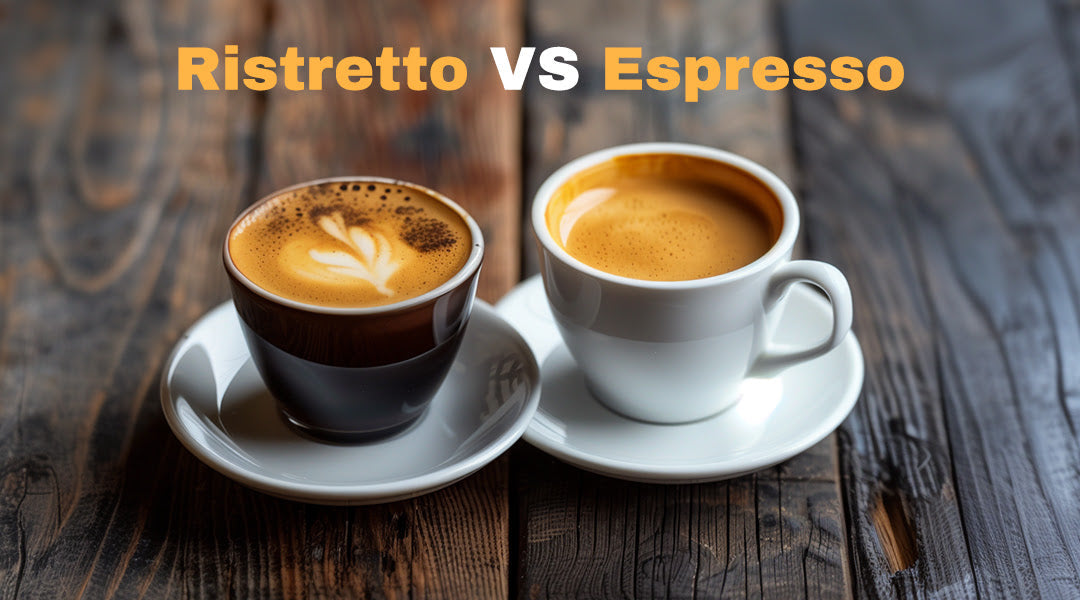
Distinguishing Ristretto from Espresso: A Detailed Comparison
If you're not deeply familiar with the world of coffee, the term 'ristretto' might be unfamiliar. Simply put, a ristretto is a more concentrated form of espresso. Let's first delve into the process of making a classic espresso and then explore how a ristretto differs from it. Understanding these differences can be quite enlightening and may even pique your curiosity to experience the unique taste of a ristretto for yourself. This exploration will not only expand your coffee knowledge but also might introduce you to a new favorite in your coffee repertoire.
What is Espresso?
Let's start by exploring the concept of espresso. Espresso is a coffee choice that offers a robust flavor profile. It is made using a machine that pushes water through finely ground tightly packed coffee beans, under high pressure. This process takes about 20 to 30 seconds and is calibrated to extract the full bodied flavors that define espresso.
What makes espresso unique is its composition. When you pour an espresso shot you'll notice three parts; the body" at the bottom, the milder "heart" in the middle and the frothy "crema" on top. The crema, which consists of air bubbles, contributes greatly to the aroma and lingering aftertaste that espresso is known for.
Many coffee enthusiasts choose to enhance their experience by opting for a double shot called a 'doppio' or even a triple shot. You can enjoy espresso as it is or add sugar based on your preference for sweetness. It's not just a drink; rather it takes you on a sensory journey with its taste, aroma and visual appeal.
What is Ristretto?

Ristretto is a variation of espresso that adds a unique touch to the brewing process. It's made using the espresso machine but with a twist. The secret lies in the timing and quantity of water used. Unlike espresso, ristretto is crafted using half the amount of water and brewed for a shorter duration. This results in a concentrated shot. These brewing differences bring about changes in terms of volume, flavor profile and caffeine content when compared to an espresso shot.
Volume: A traditional espresso shot usually measures 1 ounce while ristretto is smaller at 0.75 ounces due to its reduced water ratio. This smaller volume intensifies the flavors and characteristics present in the coffee.
Flavor Profile: Because ristretto has a shortened extraction time it captures a range of flavors compared to regular espresso. The result is a highly concentrated taste often accompanied by a noticeably sweeter finish than its espresso counterpart. This unique characteristic arises from the fact that less time is spent extracting some of the bitter compounds found in coffee beans.
Caffeine Content: The amount of caffeine in a ristretto is actually slightly lower compared to an espresso shot. This is because the shorter extraction time doesn't extract caffeine from the coffee grounds. While the difference in caffeine levels is small it could be important for those who're sensitive to caffeine or prefer a milder coffee experience.
The unique preparation method of ristretto offers a nuanced coffee experience that appeals to those who enjoy bold nuanced flavors.
Choosing Between Ristretto and Espresso

When it comes to selecting between ristretto and espresso, it's essential to understand their unique characteristics and how they cater to different taste preferences.
Ristretto at a Glance:
- Utilizes half the amount of water compared to espresso.
- Each shot is about 0.75 ounces.
- Features a shorter extraction time, leading to a more concentrated essence.
- Offers a richer, more intense flavor with a noticeable sweet undertone.
- Contains marginally less caffeine than espresso.
Espresso at a Glance:
- Requires twice the water used in a ristretto.
- Typically served as a 1-ounce shot.
- Has a longer extraction time, providing a classic, well-rounded espresso taste.
- Known for its signature bold flavor profile.
- Slightly higher in caffeine content compared to ristretto.
Making Your Choice:
When deciding between ristretto and espresso there are some things to consider. If you already enjoy espresso, trying ristretto can be an experience. It's becoming more popular in coffee shops as it offers a variation in taste. People who prefer ristretto often praise its flavor profile and sweeter aftertaste.
Interestingly some coffee places have embraced ristretto so much that they use it as the default for their espresso based drinks. A notable example is Starbucks, where flat whites are made with ristretto shots by default. This trend highlights the growing popularity of ristretto, among coffee lovers.
If you ever find yourself at a coffee shop why not try out a ristretto shot? It's a way to explore flavors and maybe even find a new favorite on your coffee journey.
Frequently Asked Questions (FAQs)
What is the main difference between a ristretto and an espresso?
A ristretto is brewed with half the amount of water. Extracted for a time compared to an espresso. This creates a bolder flavor profile, with a pleasant sweetness while espresso offers that classic bold taste.
How much caffeine is in a ristretto compared to an espresso?
Although the difference in caffeine content is relatively small due to its extraction time ristretto has less caffeine than espresso.
Can I order a ristretto at most coffee shops?
Indeed ordering a ristretto is quite common at coffee shops. Some places, like Starbucks even default to using ristretto shots in espresso based drinks such as whites.
Is ristretto stronger in flavor than espresso?
It's worth noting that ristrettos are generally known for their more concentrated flavor due to the reduced amount of water used and brewing time.
How does the preparation of ristretto and espresso differ?
Both ristrettos and espressos are brewed using an espresso machine. However, making a ristretto involves using half the amount of water and extracting it for a shorter time then an espresso.
Check out Lifeboost Coffee Embolden Dark Roast.







